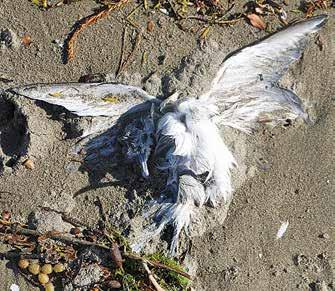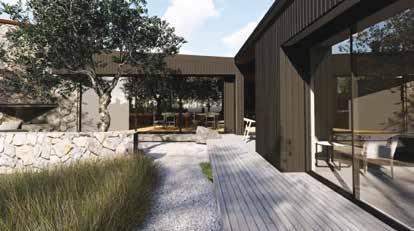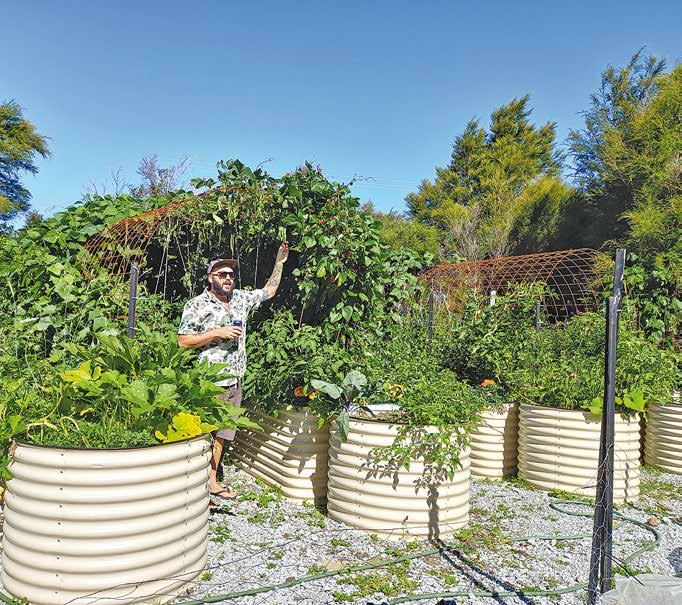
8 minute read
Fairy prion strandings a mystery
ANITA PETERS
Large numbers of young fairy prions were washed up on Golden Bay beaches last week, in an identical tragedy to five years ago.
Advertisement

In 2018, at the same time of year, the stranding of many hundreds of birds across Golden Bay was attributed to rising sea water temperatures, coupled with bad weather.
The same scenario played out on the tail end of the recent storm that caused major flooding in the North Island. Various experts have suggested the warmer water indicates a marine heatwave related to climate change.
Golden Bay shorebird protection advocate and Forest and Bird member Cynthia McConville said that a recent study on crabs – a major food source for birds – has noted them running from the water when it becomes too warm.
“Climate change isn’t just a huge thing for us,” she said. “It’s a major challenge too for our seabirds and shorebirds.”
Once fledged, the fairy prions are left to fend for themselves. They are surface feeders, dependant on mainly small fish, crustaceans and squid that inhabit the top 10cm layer of water. With the increasing water temperatures, however, the fish are forced to seek cooler waters, thus removing themselves as the easiest food source for the young birds. In bad weather, new fledglings are often blown shoreward, “storm-wrecked” and starving, to strand on the coast. They then can also suffer attack from Southern black-backed gulls.
New Zealand’s largest breeding colony of fairy prions is on Stephens Island in the Cook Strait, with many more on other offshore islands to the south. At this time of year, the young have just fledged, aged between 43 and 56 days. They usually feed in large flocks over open ocean or near offshore rocks and islands, but rarely over sheltered coastal waters. They are not adept at foraging on shore.
Despite so many dead birds washing up on the shoreline, there were some rescued alive – but sadly with few successful outcomes. Bird rescue expert Inge Bolt said that the “fifteen or so” birds delivered to the veterinary clinic were dehydrated and underweight. Despite crop feeding a rehydration mixture of glucose and saline, they failed to put on weight, and most have since died.
Other seabirds are also suffering, according to bird rescue member Marian Milne. Marian is currently involved in the complex task of translocating fluttering shearwaters to Cape Farewell.
“All Cook Strait shearwaters are doing poorly this year, with reports of late breeding, and low chick and adult weights,” she said.
Inge Bolt stresses the importance of determining whether mass strandings were caused by environmental changes or due to disease. Either way, Ministry for Primary Industries (MPI) should be informed to undertake further investigation and possible post-mortems.
The Rural Service Centre veterinary clinic will take on sick wildlife as a service and can call on support from other organisations when needed.

EXCLUSIVE to ITM
Purchase any ITM Trade Series product between 1st February - 31st March '23, then enter online and you're in the draw to win one of eight Little Giant 3 Step Jumbo Ladders (LJS3) valued at $320 each.
Ask Sol
Each month Sol will answer your questions on a specific topic through his regular column.
To take part, submit your questions via email with the subject heading “Ask Sol” to: admin@gbweekly.co.nz
This month’s subject: Crop harvest and storage Deadline for questions: 12pm on Wednesday 15 February
Rainfall
January 2023
Rainfall Raindays Heaviest fall
Te Hapu 82mm 11 18mm on the 5th
Kaihoka 101mm 9 23mm on the 4th
Hamama 144mm 14 46mm on the 29th
PŌhara 156mm 8 57mm on the 5th
Glenview Rd 163mm 15 68mm on the 5th
Ōnekakā 167mm 12 62mm on the 6th
Ligar/Tata 173mm 14 67mm on the 5th
Puramahoi 174mm 14 63mm on the 5th
Bainham 180mm 15 81mm on the 5th
GoldenBayPropertyServices.co.nz
* Window Cleaning
* Water Blasting
* Roof-Building Washing
* Gutter Inspection/Cleaning
* Lawns/Grounds Maintenance
* Drone Inspection/Surveys
027 690 0769 | Free Quotation
Local People providing Local Service
DOWN TO EARTH: Raised beds
Daniel Bruning - Diggs 027 307 8774 diggslimited@gmail.com
Many keen gardeners will know the pain of getting older and not being able to do what we were once able to. For those who find bending or kneeling difficult, a more upright garden bed becomes a necessity. Here are some options.
Recycled mussel buoys:
These locally available, durable, heavy plastic buoys make great raised gardens. Either cut in half or remove just the top third and set up on a frame of some kind. This offers a cheap solution for gardening without bending over. Being black, they do heat up – great for getting crops going, and heat-lovers like peppers enjoy that. But they do dry out, especially on the edge. Local mussel farm operators are very approachable for old buoys.
Wooden beds:
Use of treated timber for raised beds is not recommended, as chemicals like copper, chromium and arsenic can leach into soil and then plants. However, pressure-treated wood with micronized copper azole is proven safe. Avoid railway sleepers, as they contain poisonous creosote. Untreated durable timbers like macrocarpa, western red cedar, swamp cypress, and other hardwoods offer a good alternative. Choose wood 50mm thick (ideally 100mm), for longer durability. The challenge is the cost and availability to build raised beds high enough. Natural treatment with oils like linseed helps preserve wood longer. Kitset options are available from outfits like https://www. macrocarpasupplies.co.nz/raised-garden-beds/.
Metal raised beds:
Utilising old iron is a cheap option but there are some pitfalls. Covering the edge so it is safe is one. Flaking paint into soil is another, especially if it is lead paint.
I recently visited a friend’s new raised beds from Birdies Garden Products, an Australian company that has a New Zealand branch at https://birdiesgardenproducts.co.nz/ collections/all. They have both corrugated iron and Corten steel raised beds available. Both are durable and long-lasting, with various shapes and styles: round, oblong and square. Safety has been taken care of with a rolled steel edge with a durable clip-on safety strip. They are reasonably priced for a permanent garden bed and come as easily set kitsets. In terms of access, I like the 750mm high by 1300mm wide and up to 2600mm long versions. This gives plenty of room to grow enough produce and store a lot of soil and bedding material.
Smaller, cheaper options are available from Bunnings: https://www.bunnings.co.nz/the-organic-garden-co-200-x100-x-41cm-monument-raised-garden-bed_p0045658.
Ferro-cement raised beds:
I have seen a number of examples of ferro-cement raised beds in the Bay, although they are mostly between 300-500mm high. Recycled material such as corrugated iron, bamboo, chicken mesh, and of course cement, can be used to construct these permanent raised beds. Concrete colouring can be added for decoration, as can shapes and different objects (like shells), to make it more than functional – beautiful too. Downside: a lot of hard work.
Advantages of raised beds:
Those of us on poor soil, or even no soil, can import soil and soil amendments into a raised bed that contains the material. This greatly improves drainage and ability to grow healthy food.
Without an edging, birds like weka tend to destroy raised beds, or at least knock all the mulch off.
Being raised, they heat up faster in the spring and remain warmer into autumn. If made of black plastic, ferro-cement, or tin, they absorb and store heat as thermal mass. This aids growth.
Disadvantages of raised beds:
It takes some investment of money and time to make them.
They also need topping up as material gets absorbed into crops removed, but this is the same really with any garden.
Raised beds dry out faster and may need more watering.
Tips for raised bed management:

Select a sunny but sheltered spot for your new raised beds, as sunlight is critical for good crop growth. Exceptions are if you plan to grow shade-loving crops like subtropical herbs, etc.
During construction, avoid having posts or stakes on the outside, for health and safety reasons. The ideal width is 1.2m wide, enough to easily reach into the middle from both sides. Allow at least 600mm between beds, for wheelbarrow access.
Add drainage material like chunky stones or even broken clay pots in the bottom, if on heavy soil or concrete.
Add a variety of organic materials to your bed: hay (lower down so seeds don’t germinate), straw, soft wood (for Hugelkultur method), manure(s), leaves, greens, topsoil (especially if your soil is poor like pākihi), worm castings, compost, and top with seagrass/seaweed. Wait a few weeks before planting to allow the mix to integrate with biology.
After a season, taking a soil test to correct any deficiencies in your soil will ensure you get a balanced fertile medium for healthy plants to grow in. A general organic mineral mix is an option, or at least add lime/dolomite mix at 200 grams per square metre.
With this new setup we can find gardening more comfortable and rewarding. Enjoy.







